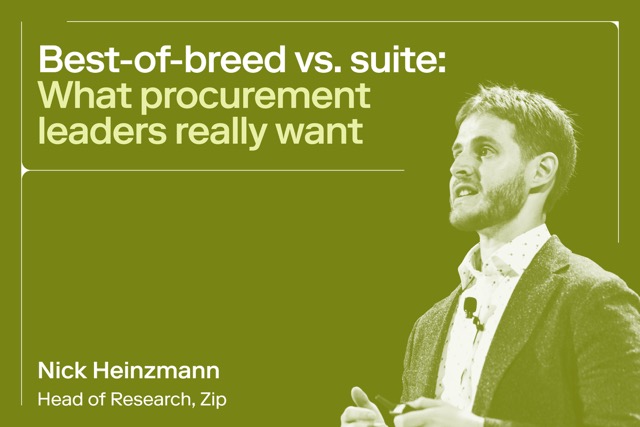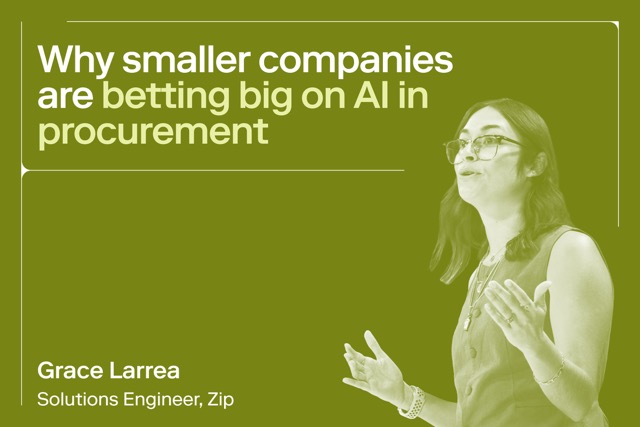
Unique factors when sourcing software and services
Learn about strategic sourcing, procurement's role, and more key considerations.

First question: What is the most significant pain point in your business?
That's what will guide your entire customer journey, and equip your company with the most efficient and cost-effective tools on the market.
Every single business needs to digitize processes. In today's increasingly competitive digital economy, choosing the appropriate software is a bigger decision than it seems.
In fact, 66% of Chief Procurement Officers (CPOs) surveyed in the 2022 Procurement Leaders CPO Compass expect supply chain volatility to persist this year.
You choose wrong, and you could be stuck with a stagnant IT infrastructure that keeps your brand from growing.
In this article, we'll examine how strategic sourcing works, where procurement plays a role, the top factors to consider, and the importance of licensing.
What Is Strategic Software Sourcing?
Sourcing the best software for your business is all about looking for suitable vendors. This includes tasks like:
- Scouting new platforms
- Vetting possible solutions
- Assessing the fit
- Selecting and managing suppliers
High-quality sourcing requires extensive research. It includes vendor expectations, as well as quality and quantity metrics.
Strategic sourcing streamlines SaaS buying to take advantage of optimal payment terms and pricing. Brands can achieve this by developing a list of preferred suppliers to build long-term, vendor relationships.
Sourcing also helps to reduce the number of suppliers, works to leverage volume pricing, and seeks advantageous terms on software purchases.
What is Software Procurement?
Software procurement is the process of buying software for a company. The procurement management function oversees strategic sourcing, purchasing, and paying for the solutions you need. While sourcing is vital for the buying process, it is only a subset of procurement in general.
The Difference Between Strategic Sourcing and Procurement
Strategic sourcing is not the same as procurement. However, the two processes are related. At a high level, sourcing is about finding the best suppliers for your business needs. Procurement, on the other hand, involves the remainder of the purchasing process.
There is typically an overlap between these two functions. In many cases, especially with small businesses, a single team may handle both duties.
Why the Procurement Process Needs Strategic Sourcing
Procurement professionals know that strategic sourcing can improve profit margins, reduce lead times, and strengthen supplier relationships.
Using strategic sourcing, a procurement department can:
- Leverage negotiations
- Shorten time to evaluate and negotiate deals
- Reduce costs of SaaS platforms
- Improve spend efficiency
- Mitigate supplier risk by giving preference to known vendors
- Streamlines accounts payable and procure-to-pay (P2P) functions
The data from the research done during this phase can also be stored and used at a later date.
What to Include in the Strategic Sourcing Process
A strategic sourcing process places your business needs front and center in the search for top software solutions. In addition, it's an excellent source of risk management and cost savings, ensuring good alignment between a business and its suppliers.
Strategic sourcing activities that are critical include:
- Market research
- A make-or-buy analysis
- Specification development
- RFQ (request for quote) or an RFP (request for purchase) selection process
#1) Identify Organizational Needs
Research what your business needs to achieve with the new software solution. This can include conversations with procurement and decision-makers.
By soliciting feedback, you'll better understand the stats of your current tech stack. It includes suppliers' performance and where improvement and/or expansion is required.
#2) Develop a Strategy
This is about understanding what your business wants to achieve from the supplier relationship beyond licensing or services. For each category of software, consider some of these factors when developing your sourcing strategy:
- Budget and usage parameters
- Non-negotiable contract terms
- Risk management
- Sustainability and diversity standards
- Service-level considerations
You might also want to think about security requirements, as well as integration needs.
#3) Shortlist Suppliers
Depending on the software category, you may already have a list of suppliers in mind. Create a shortlist beyond your favorites and conduct a competitive analysis, benchmarking where possible.
It helps a business get a preliminary understanding of essential issues like implementation requirements, budget impacts, and long-term feasibility.
#4) Vet and Engage Suppliers
The next step is to vet each supplier according to your internal requirements. Finally, you can use tools to access buying data on supplier downtime and remove any unsuitable vendors from your list of considerations.
Once the sourcing strategy and prerequisites are clearly defined, you'll have the information to negotiate effectively with suppliers. In this instance, a direct understanding of non-negotiables yields a much smoother process and better results.
This is where a procurement software solution like Zip comes in. The platform makes it incredibly easy for end-users to request a significant purchase before they've engaged a vendor, so you can do what you do best: strategically source. In addition, the software helps to automate vendor approvals and reduce cycle time, making it easier to shorten your list and engage the right people.
Now that you've identified suitable suppliers, it's time to engage them. The questions come down to pricing, contract terms, delivery schedules, payment terms, and performance guarantees.
#5) Contracts and Onboarding
Once negotiations are complete, it's time to ensure compliance with a strategic sourcing policy. A procurement software solution expedites this process, as preferred vendors are typically already in the system. Users can then access these suppliers through a curated marketplace.
If they are new to the system, then this is where the contract must be signed, and the onboarding process begins.
#6) Continuous Improvement
Monitor supplier relationships over time and keep your lists updated. This will ensure vendors continue to align with your procurement goals and organizational tactics.
Creating a thorough supplier evaluation process is crucial to a healthy supplier lifecycle. It can also help a business course correct struggling relationships and make offboarding suppliers a more manageable process when the time comes.
Top Considerations When Sourcing Software and Services
When selecting the perfect software for your business, there are some primary considerations for strategic sourcing. These are:
Budget Ceiling
This will be a defining factor in the type of software you purchase. Affordability is not usually a feature we choose, but rather, something we need. Therefore, the strategic sourcing process all starts with money and how much you have to spend.
Keep in mind, software can range in the tens of thousands, including monthly subscriptions and installation fees. All of this must be taken into consideration when sourcing software solutions. Prices can sneak up on you, and some plans have hidden costs that can substantially add to the bottom line.
Ask all the right questions upfront, and you won't be stuck with a surprise bill later on. The good news is, there is so much competition, a business of any size is bound to find a solution that fits.
Learning Curve
How long will it take your staff to learn the software? What type of training and onboarding is involved? Learning a new system can be tricky, especially if the product/service is complex.
You'll need a good understanding of how long it will take employees to get comfortable with the product, and how sharp the learning curve will be. The longer it takes to train, the more expenses are involved.
Scalability
Does your business intend to grow over the years? Then you need to look for solutions that give you room to expand. Does the software have the functionality and bandwidth to increase in size when needed? If the platform you're considering has features that are already outdated, then you should look elsewhere.
Customer Support
Research reports that 96% of customers would leave your business if they had a bad experience. That's a considerable number.
The less experience a company has with the software, the stronger the customer support should be. There's no use in purchasing a platform if you don't know how to use it and can't get customer service on the phone. Or worse, it breaks unexpectedly, and no one returns your emails. The frustration levels boil over.
Doing the research upfront will save you the headache of an absent tech team down the road. Your best bet here is to start with online reviews. If people receive poor customer service with a software solution, that's the first thing they will report online.
If you don't see a slew of complaints, check the website next. They will usually list in the "contact" section all the ways in which you can reach out. If this is limited to just chat, that can also be a red flag that the brand isn't efficiently handling customer service queries.
You want a solution to offer phone service and live humans 24/7, or have local support teams based in your country. That's the ideal customer service scenario.
In-Depth Reporting
One of the main functions of an efficient software solution is the ability to gain critical insights through in-depth reporting. You should be able to run reports quickly, analyze data, and study trends for areas of improvement.
Before you buy, make sure the platform's reporting capabilities are on par with the insights you need for key decision-making. If not, running reports will be futile, and you won't receive the full benefits of automation. Great software solutions are designed to save you time, not create more headaches.
Ongoing Maintenance
Software is not a static product, and it's not something you purchase once, and you're done. If you want it to last, there must be a maintenance schedule to keep all tools updated. Sometimes, this also requires ongoing fees and new versions being released.
A business should designate one staff member to oversee updates and ongoing maintenance. This is typically the IT department's responsibility, but in a smaller organization's case, that might not be an option.
Nevertheless, someone must maintain the software. Operating with an outdated version can put your company's security at risk, including exposing important data to hackers.
When purchasing software, maintenance should be mentioned in the terms and conditions. Some terms to consider include:
- Ongoing maintenance and upgrade entitlements
- Exit provisions
- Removal and reinstatement of licenses
- Support annual incremental charges
The terms and conditions will vary depending on the value and complexity of the software you purchase.
Integration
The software solution you purchase should integrate efficiently with existing systems. Otherwise, you might bite off more than you can chew. If you purchase software that does not work well or communicate with legacy systems you already have, you might end up replacing more systems than intended.
When considering a hybrid or cloud solution, you'll also have to look at the integration between your cloud applications and other systems. The decisions you arrive at should successfully add value to existing systems, and not complicate things further for employees.
Additional Features to Consider
- Security and encryption - How safe is your data?
- Customization - Can they tailor the product to your business?
- Data migration - How easy is it to move all of your old info to the new system? Can you capture and utilize big data?
Software Licensing
When sourcing software and services, you cannot overlook the aspect of licensing. Who owns what, and what do you have access to? When purchasing software, there are two common licenses:
Perpetual License
This is a one-off payment for a license and has no annual renewal or subscription fees.
Term or Subscription License
This type of license is granted by the software developer for an agreed-upon period of time. A fee will be charged throughout that period for usage, and upon expiry, both parties can agree upon the expansion of terms. Otherwise, the customer is expected to cease usage of the platform.
A wide variety of software licenses exists, ranging from single-user to enterprise agreements.
Summing Things Up
Almost 79% of CPOs interviewed said they seek to improve supplier diversity and inclusion. Competition is fiercer than ever!
Buying software is not easy, but it's absolutely critical you do your homework. Strategic sourcing is the first step in procurement, and it involves the careful planning that surrounds making a purchasing decision. Without it, you might as well play eenie-meanie-minie-mo with buying.
Therefore, some due diligence is in order before spending considerable money. Consider your budget, learning curve, licensing, integration, and weigh the pros and cons. The more time spent on the front end of procurement, the more likely you are to be satisfied with the decision.
When in doubt, consult an IT expert. Procurement is streamlined when you have a dedicated software solution for it. Zip is a prime place to start when automating your buying strategies. Click here to get started with a free demo today!

Maximize the ROI of your business spend

Enter your business email to keep reading






.webp)


